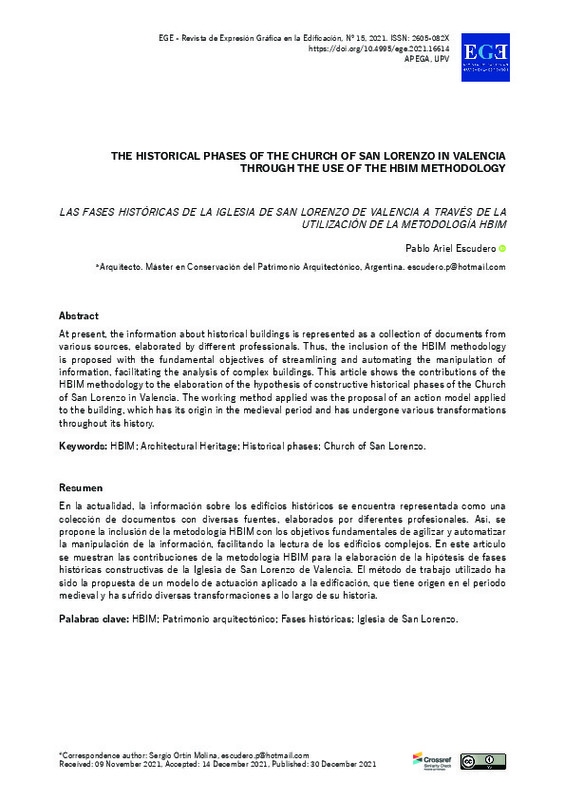JavaScript is disabled for your browser. Some features of this site may not work without it.
Buscar en RiuNet
Listar
Mi cuenta
Estadísticas
Ayuda RiuNet
Admin. UPV
Las fases históricas de la Iglesia de San Lorenzo de Valencia a través de la utilización de la metodología HBIM
Mostrar el registro sencillo del ítem
Ficheros en el ítem
| dc.contributor.author | Escudero, Pablo Ariel
|
es_ES |
| dc.coverage.spatial | east=-0.3750124; north=39.4778168; name=Iglesia de San Lorenzo, Valencia, Espanya | es_ES |
| dc.date.accessioned | 2022-01-03T08:21:11Z | |
| dc.date.available | 2022-01-03T08:21:11Z | |
| dc.date.issued | 2021-12-28 | |
| dc.identifier.issn | 1888-8143 | |
| dc.identifier.uri | http://hdl.handle.net/10251/179200 | |
| dc.description.abstract | [EN] At present, the information about historical buildings is represented as a collection of documents from various sources, elaborated by different professionals. Thus, the inclusion of the HBIM methodology is proposed with the fundamental objectives of streamlining and automating the manipulation of information, facilitating the analysis of complex buildings. This article shows the contributions of the HBIM methodology to the elaboration of the hypothesis of constructive historical phases of the Church of San Lorenzo in Valencia. The working method applied was the proposal of an action model applied to the building, which has its origin in the medieval period and has undergone various transformations throughout its history. | es_ES |
| dc.description.abstract | [ES] En la actualidad, la información sobre los edificios históricos se encuentra representada como una colección de documentos con diversas fuentes, elaborados por diferentes profesionales. Así, se propone la inclusión de la metodología HBIM con los objetivos fundamentales de agilizar y automatizar la manipulación de la información, facilitando la lectura de los edificios complejos. En este artículo se muestran las contribuciones de la metodología HBIM para la elaboración de la hipótesis de fases históricas constructivas de la Iglesia de San Lorenzo de Valencia. El método de trabajo utilizado ha sido la propuesta de un modelo de actuación aplicado a la edificación, que tiene origen en el periodo medieval y ha sufrido diversas transformaciones a lo largo de su historia. | es_ES |
| dc.language | Español | es_ES |
| dc.language | Inglés | es_ES |
| dc.publisher | Universitat Politècnica de València | es_ES |
| dc.relation.ispartof | EGE Revista de Expresión Gráfica en la Edificación | es_ES |
| dc.rights | Reconocimiento (by) | es_ES |
| dc.subject | HBIM | es_ES |
| dc.subject | Architectural Heritage | es_ES |
| dc.subject | Historical phases | es_ES |
| dc.subject | Church of San Lorenzo | es_ES |
| dc.subject | Patrimonio arquitectónico | es_ES |
| dc.subject | Fases históricas | es_ES |
| dc.subject | Iglesia de San Lorenzo | es_ES |
| dc.title | Las fases históricas de la Iglesia de San Lorenzo de Valencia a través de la utilización de la metodología HBIM | es_ES |
| dc.title.alternative | The historical phases of the church of San Lorenzo in Valencia through the use of the HBIM methodology | es_ES |
| dc.type | Artículo | es_ES |
| dc.identifier.doi | 10.4995/ege.2021.16614 | |
| dc.rights.accessRights | Abierto | es_ES |
| dc.description.bibliographicCitation | Escudero, PA. (2021). Las fases históricas de la Iglesia de San Lorenzo de Valencia a través de la utilización de la metodología HBIM. EGE Revista de Expresión Gráfica en la Edificación. 0(15):104-119. https://doi.org/10.4995/ege.2021.16614 | es_ES |
| dc.description.accrualMethod | OJS | es_ES |
| dc.relation.publisherversion | https://doi.org/10.4995/ege.2021.16614 | es_ES |
| dc.description.upvformatpinicio | 104 | es_ES |
| dc.description.upvformatpfin | 119 | es_ES |
| dc.type.version | info:eu-repo/semantics/publishedVersion | es_ES |
| dc.description.volume | 0 | es_ES |
| dc.description.issue | 15 | es_ES |
| dc.identifier.eissn | 2605-082X | |
| dc.relation.pasarela | OJS\16614 | es_ES |
| dc.description.references | Brumana, R., Oreni, D., Raimondi, A., Georgopoulos, A., and Bregianni, A. 2013. "From survey to HBIM for documentation, dissemination, and management of built heritage: The case study of St. Maria in Scaria d'Intelvi". 2013 Digital Heritage International Congress (DigitalHeritage). Marseille, France. https://doi.org/10.1109/DigitalHeritage.2013.6743789 | es_ES |
| dc.description.references | buildingSMART Spanish Chapter. 2018. Guía de usuarios BIM aplicado al Patrimonio Cultural [en línea]. Disponible en: https://www.buildingsmart.es/bim/guías-ubim/[consultado el 20/11/2021]. | es_ES |
| dc.description.references | Castellano-Román, M., and Pinto-Puerto, F. 2019. "Dimensions and Levels of Knowledge in Heritage Building Information Modelling, HBIM: The model of the Charterhouse of Jerez (Cádiz, Spain)". Digital Applications in Archaeology and Cultural Heritage, 14, e00110. | es_ES |
| dc.description.references | DOCV, Diario Oficial de la Comunidad Valenciana. Decreto 57/1993, de 3 de mayo, del Gobierno Valenciano, por el que se declara Bien de Interés Cultural el conjunto histórico de Valencia. | es_ES |
| dc.description.references | Dore, C., and Murphy, M. 2012. "Integration of Historic Building Information Modeling (HBIM) and 3D GIS for Recording and Managing Cultural Heritage Sites". 18th International Conference on Virtual Systems and Multimedia: "Virtual Systems in the Information Society", (págs. 369-376). Milan. | es_ES |
| dc.description.references | Ferrer Orts, A. (julio-diciembre de 2016). "La Iglesia y el convento de San Lorenzo (Valencia), antigua sede de la provincia franciscana de San José de Valencia, Aragón y Baleares". Hispania Sacra, LXVIII(138), 491-501. https://doi.org/10.3989/hs | es_ES |
| dc.description.references | Historic England. 2017. Historic England BIM for Heritage: Developing a Historic Building Information. | es_ES |
| dc.description.references | Santoni, A., Martín-Talaverano, R., Quattrini, R., and Murillo-Fragero, J. 2020. "HBIM approach to implementing the historical and constructive knowledge. The case of the Real Colegiata of San Isidoro (León, Spain)". Virtual Archaeology Review, 0. https://doi.org/10.4995/var.2021.13661. | es_ES |








